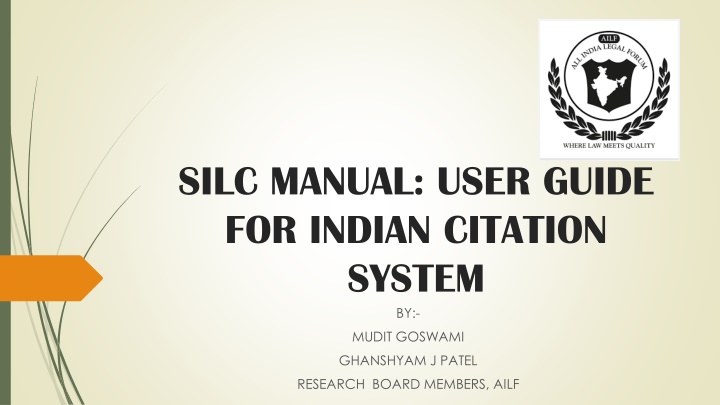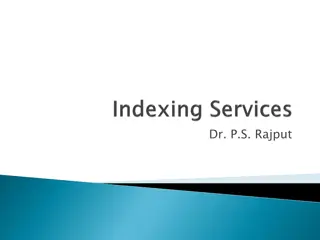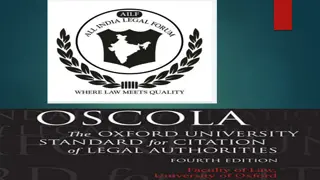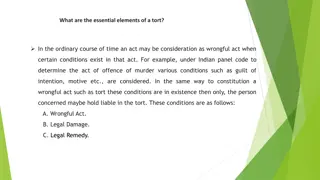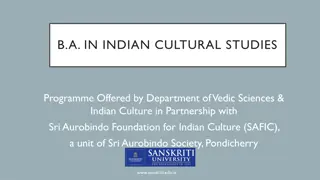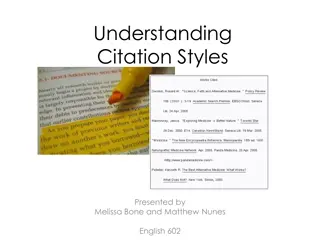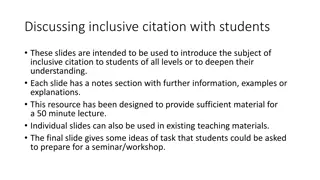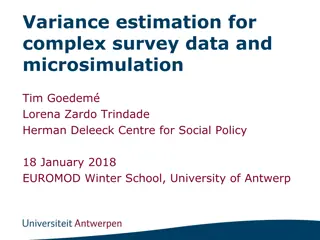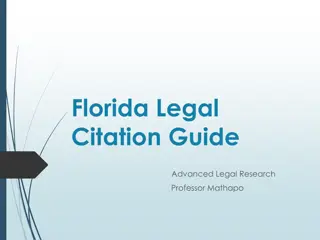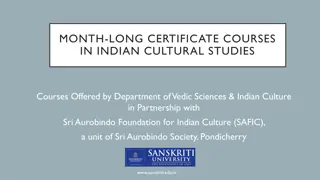Standard Indian Legal Citation (SILC): User Guide and Overview
Standard Indian Legal Citation (SILC) is a unique reference framework designed to cater to India's legal community by incorporating the rich legal traditions and history of the country. Led by prominent legal professionals, SILC aims to establish a standardized citation system specific to India. The introduction, background, objectives, and distinctions from foreign citation guides are highlighted to promote consistency and accessibility in legal research and documentation within India.
Download Presentation

Please find below an Image/Link to download the presentation.
The content on the website is provided AS IS for your information and personal use only. It may not be sold, licensed, or shared on other websites without obtaining consent from the author.If you encounter any issues during the download, it is possible that the publisher has removed the file from their server.
You are allowed to download the files provided on this website for personal or commercial use, subject to the condition that they are used lawfully. All files are the property of their respective owners.
The content on the website is provided AS IS for your information and personal use only. It may not be sold, licensed, or shared on other websites without obtaining consent from the author.
E N D
Presentation Transcript
SILC MANUAL: USER GUIDE FOR INDIAN CITATION SYSTEM BY:- MUDIT GOSWAMI GHANSHYAM J PATEL RESEARCH BOARD MEMBERS, AILF
INDEX Introduction Background Aim and Objective Difference between SILC and other Foreign Citation Guides Citation guide as per SILC Conclusion Bibliography
INTRODUCTION Standard Indian Legal Citation (SILC) is an India-driven reference framework created to furnish the Indian lawful network with a solitary reference technique that considers India's rich legitimate customs and history. This is a big development in the history of legal academia in India! India will now have its own standardized Legal Citation System. Led by Rohit K. Pothukuchi (NALSAR graduate, LLM from UC Berkeley School of Law, Founder & Chief Executive at Verdentum), Debanshu Khettry (NUJS graduate, LLM from Univesity College London, Principal Associate at his firm, Khettry) and Shambo Nandy (NUJS graduate, the Executive Editor of Journal of Indian Law and Society Blog), the Standard Indian Legal Citation (SILC) is supported by leading academics and lawyers in India.
BACKGROUND Indian lawful organizations have seen a critical spray in research about yield and the production of journals: in the previous 5 years alone, driving lawn schools have built almost 30 academic journals. While this is a superb advancement for Indian Legal scholarly community, various varying parameters are being utilized the country over for reference and research, causing critical dissimilarity and anomaly. Significant journals in India presently follow reference frameworks that have not been grown indigenously. Lawful establishments and colleges have shifting reference measures for venture entries and in-class work, a few colleges need clear reference rules and rules by and large. SILC would like to bring together experts, academics, and undergraduates of the country over in their research works SILC is being created by Indian academicians, undergraduates, and experts, huge numbers of whom have filled in as journals editor. SILC is informed by some concerning India's driving legal advisors and international legal specialists.
AIMS AND OBJECTIVES SILC plans to introduce a time of consistency in the reference practices of Indian research works, graduate schools, and by expansion, lawful documentation in India. SILC plan to give a reference framework that is basic, simple, and one of a kind to India. Some basic objectives are as follows: 1. Giving a reference framework that exhaustively covers Indian legitimate sources and material, not secured by foreign citation guides. 2. Giving a simple to utilize and simple to get to reference or citation framework that will consistently be free from any cost. 3. Getting consistency the acts of law diaries and graduate schools across India, and by augmentation, increment availability between law schools and indigenous journals in the country.
DIFFERENCE BETWEEN SILC AND OTHER FOREIGN CITAION GUIDES As SILC provides comprehensive guide for citing legal sources and other stuff. Many of the things are there which other foreign citation guides doesn`t cover as such. Here are these materials: 1. Parliamentary committee reports 2. Parliamentary debates 3. RBI/SEBI Circulars and notifications 4. Law Commission reports 5. Reports by ministries 6. more; SILC contains an entire chapter of Indian legal sources
CITATION GUIDE AS PER SILC It contains various of citing materials such as Cases, Legislative Materials, Articles, Books, Electronic sources, Law Commission Reports, Working and Forth working Papers. It also contains guide to cite International Sources viz. Case Law, Statutes, Constitutions, United Nations Sources. Further slides will deal with the some of the major citing materials.
Indian Cases A case citation for a published judgment includes the full name of the case, the citation as per the reporter in which it is published and the first page of the case. In order to cite an un-published judgment, first note the name of the parties followed by the case/appeal number. It should be followed by the name of the Court and the date the judgment was passed in parenthesis. The name of the parties should be separated with a v. . The case/appeal number will be the number assigned to the judgment by the Court. Citing Method: Names of the Parties, Citation. Examples: 1. Kesavananda Bharati v. State of Kerala, AIR 1973 SC 1461, 1480. 2. Charan Lal Sahu v. Union Carbide, (1989) 1 SCC 674. 3. Singh v. Punjab, (1980) 2 SCJ 475, 524.
Legislative Materials Statutes: In order to cite a primary legislation, first mention the Section/ Order/ Rule number, followed by the name of the Statute and the year it was passed. To indicate a section, a capitalized letter S. should be used. To indicate multiple sections, Ss . should be used. Citing Method: : S. | Section number/Order Number/ Rule Number, Name of the statute, Year. Examples: 1. S. 376(2) (g), The Indian Penal Code, 1960. 2. Ss. 25, 26 & 27, The Indian Contract Act, 1872. 3. Order 1, Rule 3, The Code of Civil Procedure, 1908 Bills: In order to cite a Bill first mention the name of the Bill, then the year it was drafted, and the current status of the Bill, if available, in parenthesis. If it is unavailable, the author can say so.
Cont. Citing Method: Name of the Bill, Year (Status of the Bill). Examples: 1. The Competition (Amendment) Bill, 2012 (pending). 2. The Prevention of Money Laundering (Amendment) Bill, 2011 (passed by Lok Sabha, 29/11/2012). 3. The Rights of Persons with Disabilities Bill, 2012 (draft bill, Sep 2012) The Indian Constitution: In order to cite any Article/Schedule of the Constitution, first mention the criterion followed by its number and the phrase the Constitution of India . To indicate an Article, Art. should be used. Citing Method: : Art./Schedule| Article/Schedule number, the Constitution of India. Examples: 1. Art. 14, the Constitution of India. 2. Schedule 9, the Constitution of India.
Cross-Reference Ibid: Ibid is used to refer to an immediately preceding authority, either exactly as it has been cited, or at a different page number. In the first case, only the term Ibid , is used, whereas in the latter case, a different page number is alluded to by following Ibid , with the word at and the relevant page number. Examples: 1. 10P.C. Markenda, Law Relating to Arbitration & Conciliation, 98 (6th ed., 2006) 2. 11Ibid. 3. 12Ibid, at 64. (NOTE: Here 64 is the page number from where the author has taken the cited statement/text). Supra: When an authority has been fully cited previously by the author, Supra is used to refer to that same authority at a later point. Supra should only be used where it is inappropriate to use Ibid .
Cont. Example: 1. 2. Framework of Ambiguity and Ineffectiveness?, 26, 39 in Outer Space Law: From Theory to Practice (Sandeepa Bhat B., 1st ed., 2009). 3. 4. first cited in the paper).47Supra 21, at 991. (NOTE: Here 21 is the footnote number where the authority was first cited in the paper and 991 is the page number from where the author has taken the cited statement/text). See: When the cited statement is not directly related to the given authority, See needs to be added as a prefix in that footnote. Example: 1. an example in the citation. This signal can be used alone or attached with any other signal.) 43V.N. Shukla s Constitution of India, 219 (M.P. Singh, 12th ed., 2013). 44S. Sen, The Principle of Common Heritage of Mankind in Outer Space: A 45Ibid. 46Supra 43. (NOTE: Here 43 is the footnote number where the authority was 24See R. v. Sinclair (2010) 2 SCR. 310. (NOTE: This may be used while giving
Law Reviews and Journals Articles published in Law Reviews or Journals are cited by mentioning the name of the author, the title of the article in italics, the volume number of the Law Review/Journal, the full name of the Law Review/Journal, the first page/starting page of the article in the Law Review/Journal, the page number containing the relevant information, and the year of publication of the Law Review/Journal in parenthesis. Citing method: Hard copy- Name of Author(s), Title of Article, Volume no. | Full Name of Journal| Starting page, Cited page (year). Online: Name of Author(s), Title of Article, Volume no. | Full Name of Journal| Starting page, Cited page| (year), URL, last seen on dd/mm/yyyy. Examples: 1. C.D. Singh, P. Pranjal & S. Arora, The Protection of Children from the Sexual Offences Act, 2012: A Critique of the Decision to Raise the Age of Consent for Sexual Relations, 3 Journal of Indian Law & Society 286, 300 (2012).
Law commission reports Law Commission Reports are cited by first mentioning the Report number followed by the phrase Law Commission of India Report , the title/ subject of the Report in italics, the page number containing the relevant information and the date of publication of the Report in parenthesis. In case the Report is available on the internet, it is followed by available at and the web address (the URL) and the phrase last seen on , and the date the web-source was last seen by the user. Citation Method: Report number Law Commission of India Report, Title/Subject, cited page number (year), URL, last seen on dd/mm/yyyy. Example: 1. 181st Law Commission of India Report, Amendment to Section 106 of the Transfer of Property Act, 1882, 8 (2002), available at http://lawcommissionofindia.nic.in/reports/181rpt.pdf, last seen on 11/11/2013.
Electronic Sources Websites Web-resources are cited by mentioning the title of the web-page in italics followed by the name of the website and the web-address (the URL). Citation Method: Title of Page, Name of website, URL, last seen on dd/mm/yyyy. Example: 1. About Us, Kulraj Broadway, available at http://www.hdilbroadway.in/aboutus.html, last seen on 23/12/2013.
Electronic Sources Blogs Blogs are cited by mentioning the name of the author(s), title of the blog- post in italics followed by the name of the blog, the web-address (the URL) and the phrase last seen on , and the date the web-source was last seen by the user. Citation Method: Author(s), Title of Blog Post, Name of Blog, URL, last seen on dd/mm/yyyy. Example: 1. G. Loomba, Will the Scourge of Manual Scavenging End: Analyzing the 2012 Bill, JILS Blog, available at http://jilsblognujs.wordpress.com/2013/01/13/will-the-scourgeof-manual- scavenging-end-analyzing-the-2012-bill/, last seen on 21/12/2013.
BOOKS Authored Books Authored books are cited by mentioning the name of the author(s), the title of the book in italics, the page number containing the relevant information and name of the editor(s), edition number, and the year of publication in parenthesis. The first and middle names of the author are to be abbreviated to initials, using only the last name in its entirety. Citation Method: Name of Author(s), Title of Book, Page Number (Editors(s), edition, Year). Examples: 1. P.C. Markenda, Law Relating to Arbitration & Conciliation, 98 (6th ed., 2006). 2. H.V. Hande, Ambekdar & the Making of the Indian Constitution, 73 (1st ed., 2009).
Cont. Edited Books Citation Method: Title of Book, Page Number (Editors(s), Edition, Year). Example: 1. V.N. Shukla s Constitution of India, 219 (M.P. Singh, 12th ed., 2013). Edited Books with Articles Citation Method: Name of Author(s), | Title of the Article, | First page, cited page number | in | Name of the Book (Editors(s), Edition, Year). Example: 1. S. Sen, The Principle of Common Heritage of Mankind in Outer Space: A Framework of Ambiguity and Ineffectiveness? 26, 39 in Outer Space Law: From Theory to Practice (Sandeepa Bhat B., 1st ed., 2009).
International sources case law Case Law United Kingdom Cases Citation Method: Name of the parties, Volume number | Reporter abbreviation | Starting Page, Cited page (Year, Name of the Court). Example: 1. R (R) v. Durham Constabulary, 2 All ER 369, 371 (2005, House of Lords). United States Cases Citation Method: Name of the Parties, Volume number | Reporter abbreviation | Starting page, Cited page (Year, Name of the Court). Example: 1. Grutter v. Bollinger, 539 U.S. 306 (2003, Supreme Court of the United States).
Cont. Cases from Other Jurisdictions Cases from other jurisdictions are cited as they are cited in their own jurisdiction. Assuming that the name of the law report arrangement referred to does not itself show the court, and the name of the court is not clear from the given citation format, the name of the court should be provided in parenthesis after the citation. Example: 1. R. v. Tang, [2008] HCA 39 (High Court of Australia). 2. R v. Big M Drug Mart Ltd, [1985] 1 SCR 295, 300 (Supreme Court of Canada).
Articles Magazines (With Volume Number) Citation Method: Hard copy- Name of author(s), Title of Article, Volume no. (Issue no.) | Full Name of Magazine| Starting page, Cited page (year). Online: Name of author(s), Title of Article, Volume no. (Issue no.) | Full Name of Magazine| Starting page, Cited page(year)URL, last seen on dd/mm/yyyy. Examples: 1. J.V.M. Sarma & V. Bhaskar, A Road Map for Implementing the Goods and Services Tax, 47(31) Economic & Political Weekly 68, 70 (2012). 2. J.V.M. Sarma & V. Bhaskar, A Road Map for Implementing the Goods and Services Tax, 47(31) Economic & Political Weekly 68, 70 (2012) available at http://www.epw.in/system/files/pdf/2012_47/31/A_Road_Map_for_Impleme ntin g_the_Goods_and_Services_Tax.pdf, last seen on 11/11/2013
Articles Magazines (Without Volume Number) Articles published in Magazines are cited by mentioning the name of the author(s), the title of the article in italics, the full name of the Magazine, the first page/starting page of the article in the Magazine, the page number containing the relevant information, and the date of publication of the Magazine in parenthesis. Citation Method: Hard copy: Name of author(s), Title of Article, Full Name of Magazine | Starting page, Cited page (Date). Soft Copy: Name of author(s), Title of Article, Full Name of Magazine (Date), URL, last seen on dd/mm/yyyy. Examples: 1. R. Dixit, The Incensed and the Insensitive, The Week 35, 37 (06/01/2013). 2. R. Dixit, The Incensed and the Insensitive, The Week (31/12/2012), available at http://week.manoramaonline.com/cgibin/MMOnline.dll/portal/ep/theWee kContent.do?programId=1073755753&conten tId=13134055&tabId=13, last seen on 11/11/2013
Articles Newspaper Articles (Print Version) Newspaper Articles (print versions) are cited by mentioning the name of the author(s), the title of the article in italics, the full name of the newspaper, the page number containing the relevant information, and the city edition and the date of publication of the Newspaper in parenthesis. The first and middle names of the author are to be abbreviated to initials, using only the last name in its entirety. Citation Method: Name of Author(s) (if given), Title of Article, Name of newspaper | page number (City edition, date). Example: 1. T. Jaipuria, In Strong Message to Road Firms, NHAI may Bar GMR from Bids, The Financial Express 1 (Kolkata, 11/01/2013).
Cont. Newspaper Articles (Online version) Newspaper Articles (online versions) are cited by mentioning the name of the author(s), the title of the article in italics, the full name of the newspaper, the date of publication of the Newspaper in parenthesis, and the web address (the URL). The first and middle names of the author are to be abbreviated to initials, using only the last name in its entirety. Citation Method: Name of Author(s) (if given), Title of Article, Name of newspaper (date), URL, last seen on dd/mm/yyyy. Example: 1. P. Swami, Runaway Grandmother Sparked Savage Skirmish on LoC, The Hindu (09/01/2013), available at http://www.thehindu.com/news/national/runawaygrandmother-sparked- savage-skirmish-on-loc/article4291426.ece, last seen on 21/12/2013.
Conclusion The need for the uniform citation system in India has became essential. Most journals in the US have a unique citation system (Blue Book), most journals in the UK have a unique citation system (OSCOLA), isn t it time India had its own system? Academicians and students across India have felt the urgent need for a citation system that takes into account India s rich legal traditions and history, its unique sources of legal information. The SILC is still in its nascent stage and continuously evolving according to the changes suggested by experts and students across India. SILC is a great effort to usher in uniformity in legal citation practices across India but the Indian legal community continues to use varying citation standards. The need of the hour is to create awareness and encourage all law schools in India to adopt SILC as citation system.
BIBLIOGRAPHY For more elaborative structure and citation codes, please click on the below given link: http://www.cnlu.ac.in/2016/Notices/MOOTS/SILC%20Format.pdf
Team- All India Legal Forum Facebook page- https://lnkd.in/g_nNPVT FB Group - https://lnkd.in/gUxfxKb LinkedIn page- https://lnkd.in/gpk9rVZ Telegram- https://lnkd.in/ggqqsrb Twitter- https://lnkd.in/g5ds-n6 Instagram - https://lnkd.in/gKJrjsh YouTube- https://lnkd.in/gtr6Tb4 Link of our website- www.ailf.in
